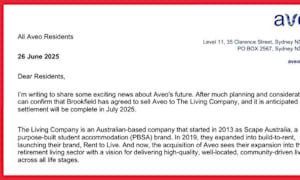Australia’s largest residential developer with approximately 5,200 homes being built a year, plus shopping centres and logistic facility development, Stockland has a capitalisation value of $8.4 billion.
Steinert (pictured left with then-Leader of the NSW Opposition Luke Foley and former Stockland Retirement Living CEO Stephen Bull) is retiring from the company after seven years, a lengthy time for a publicly listed CEO. Under his leadership, shares in Stockland have increased 52%. He states in the Financial Review his biggest achievement is the tripling of the value of their logistics portfolio to $2.5 billion and a further pipeline of $2.5 billion.
"If you look at profit growth, another measure of relative success, between FY13 and FY19 our compound annual growth rate was sitting at just under 10 per cent versus a key peer group average growth of around 5 per cent," he said.
Retirement has been another story. Stockland has travelled the same path as the other listed majors like Aveo and Lendlease. When he joined in January 2013, David Pitman was CEO of Stockland Retirement and the return on assets was 4%. He departed in June, to be replaced by Stephen Bull who had the objective of building the return to 8% by 2018.
Bull got to 6% when Four Corners hit in June 2017, and return on assets for Stockland Retirement was knocked back to 4% – and has stayed there.
Steinert placed the retirement business quietly on the market around 2015 to attract a 50% or higher investor but has been unsuccessful in getting interest at a value that was acceptable.
A major challenge is the age of the portfolio, with a majority of villages over 25 years old. Stephen Bull actively renovated villages but had to compete with the rest of Stockland to get the capital – and it’s a big portfolio, around 65 villages.
They have rationalised, selling a number of villages, plus held the number of new units being developed steady, building and selling an average of 70 new units a year. Relative to 5,200 new homes a year for the overall company, this would not be exciting business.
Around 2016 the company decided to test a ‘retirement village light’ model, which they called Aspire. Kicking off with two developments in Sydney and Perth within Stockland greenfield developments, Aspire offers the benefits of a retirement village under a strata model with no DMF. Both are up to stage III in their development and sales.
In February 2019 Steinert announced that Stockland would enter the land lease community market, with three sites across Townsville and the Sunshine Coast. They now claim to have 10 sites earmarked. He said at the time that Stockland was “finding it hard to compete” against land lease communities with the retirement village product.
The challenge for Stockland has been that as a group when they commit, they do things extremely well, and that has a cost.
At the official opening of the The Residences, Cardinal Freeman in Ashfield (Sydney), a seven-year village redevelopment program, Steinert said it was:
“an exemplar project that sets the standard, not just for retirement, but for apartment-style living. We believe this is a true reflection of density done well. We believe we are setting the benchmark for independent apartment living not only in Australia but for the world.”
It is. Their Newport development north of Brisbane (Scarborough) is in the same category.
But you need sales. Pre-Christmas 2019 Stockland retirement executives were saying that the village market was feeling vibrant to the level of pre-Four Corners/June 2017. Then we had COVID.
The good news is COVID-19 is creating a new customer for retirement villages seeking the core value propositions of security and community. But history shows that this new emotion will only have a shelf life of six to 12 months. The sector must capitalise on the new interest now – or miss the boat.
The question is what will the new CEO of Stockland think about retirement? His or her board, and the market, is seeking a return on assets between 10 and 15%, while the billion dollars in retirement is returning sub 5%?
Interesting times.











